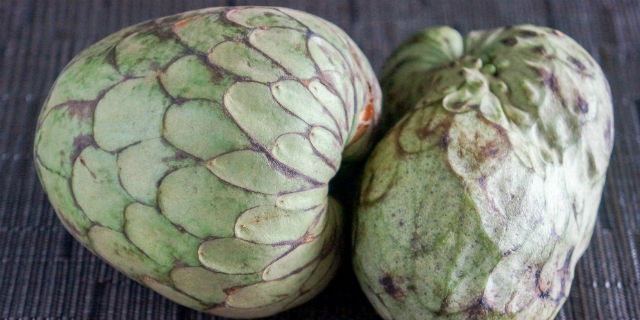How do I pick the best cherimoyas?
Whether you’re in an open market or the super market, to choose the best cherimoya go by feel first. The fruit should be heavy for its size and firm though yielding to gentle pressure. The skin may appear armor-like, with scales, and will have dull, green coloring. But don’t let that fool you. In this instance coloring is not a reliable indicator of ripeness. Instead, inspect the skin and choose a fruit that has smooth, thin skin. Pass on any fruits that have bruising, soft spots, cuts or dents.
If you are not going to enjoy your picks within a few days, choose fruits that are a bit firmer and allow them to ripen at home away from direct sunlight. Cherimoyas may not be the prettiest fruits, but when they are ripe they smell incredibly sweet. When you’re ready, give them a whiff, slice and enjoy!
What can I make with cherimoyas?
Cherimoya, because of its creamy consistency, is often scooped out and eaten raw. It can be cubed and added to salads, tossed into smoothies or pureed for pastries and pies. Add cherimoya wherever a hint of tropical flavor is welcome. From agua fresca to blackberry cherimoya tarts, the possibilities are endless.
To prep a cherimoya, rinse under cool water, peel, halve and remove seeds. Then slice, dice and cube as needed. For storage, look no further than your kitchen table. Cherimoyas will continue to ripen and sweeten at room temperature. If you won’t be enjoying your picks within a few days, refrigerating the cherimoyas in the crisper will keep them fresh for an additional 3-4 days.
Recipes to try include: Chirimoya Alegre, Atole de Fruta and Super Green Tea Smoothie (sub pear for cherimoya!).


![Making Mealtime Matter with La Familia: Easy Sofrito [Video]](https://thelatinkitchen.com/wp-content/uploads/2015/10/sofrito-shutterstock__0-500x383.jpg)
![Easy Latin Smoothies: Goji Berry Smoothie [Video]](https://thelatinkitchen.com/wp-content/uploads/2015/12/goji_berry-shutterstock_-500x383.jpg)
















![Fun and Fast Recipes: Fiesta Cabbage Salad [Video]](https://thelatinkitchen.com/wp-content/uploads/2015/11/fiesta_cabbage_slaw-shutterstock_-500x383.jpg)









